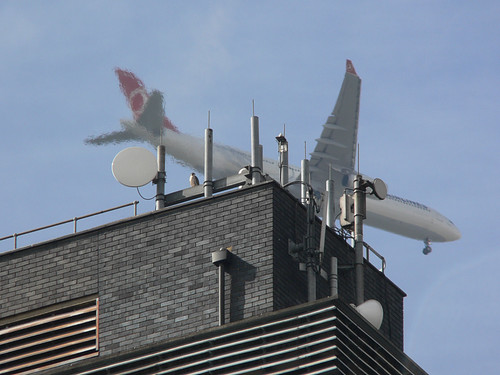Interviewed: @FaBPeregrines on the wild hunters stalking the city skies
Mike Pollitt | Tuesday 22 May, 2012 13:49

“I just love them,” says Nathalie Mahieu. “The first time I saw one I was immediately hooked.”
Nathalie is talking about Tom and Charlie, a pair of peregrine falcons who have been living on the roof of Charing Cross Hospital in Fulham since late 2007. Each year since they have roosted there. Each day they have killed something.
Nathalie feels very close to them. Five years ago it was she who spotted their arrival, and now she is their representative in the human world. She’s their Twitter feed, their blog, their Flickr group and the recorder of their lives. This closeness is no surprise, for she can see the birds from her living room.
This spring, so can everyone else. A live webcam, set up by Big Cat Diary and Springwatch naturalist Simon King, is trained on the nest and can be watched online, from any living room, iPad or phone, 24 hours a day.
The webcam has changed things.
“There’s been a huge upsurge in interest this year,” says Nathalie, whose Twitter following has quadrupled in the last few months. “When the chicks hatched, the webcam site crashed.”
There are three chicks (the adults trod on their fourth egg), fluffy bundles of down who can look adorable until they are chomping down macerated parakeet flesh, as lurid green newly-plucked feathers swirl around them on the breeze. The webcam doesn’t come with a watershed. Songbirds are filleted for lunch. It’s unedited, brutal truth, like reality TV was always supposed to be.
As Springwatch has shown, live coverage of the animals amongst us can make compelling viewing. The storylines are the made from the most elemental dramas: heroes and villains, chance and fate, life and death. The setting, above a hospital, with the gravestones of a cemetery visible in the background below the nest, is a location manager’s dream.
Peregrines make fine stars. If charm can be defined as “a hint of danger”, then these birds almost have too much. And they have the looks to go with it: sharp talons, sharp beaks, sharp eyes. They seek the limelight, having been spotted on Tate Modern, the girders of the O2, and the Houses of Parliament. And what’s more, says Nathalie, “they are happy to nest in man made boxes with cameras near them”.
They also have a history, and a language, so rich it can’t help but compel. Their ancestral nests are called eyries, their chicks eyasses, the adult male is a tiercel. Their attack dive, which reaches world-beating, scarcely credible speeds in excess of 250mph, is called a stoop. This is the specialised vocabularly of a very special bird.
Driven almost to extinction in the UK by pesticide use in the middle of the last century, they have rebounded in recent years and made cities their home in a way few big wild predators, save perhaps the urban fox, have managed.
Nathalie says there are a certain 25 pairs in the Greater London area, though the number of individuals will probably be higher. It’s a story repeated in cities across the world. From the cathedrals of Barcelona to the skyscrapers of New York , the birds are coming back. They find cliffs in our sheer concrete buildings, and plentiful prey in the pigeons plumped up by human crumbs.
Humans tend not be good at living with wild animals, especially ones which kill as much as we do. But perhaps the webcam points to a more tolerant future.
“It’‘s a very positive thing. When you involve local people [they] become their birds,” Nathalie says. The more people know, the more people will look out for them, and the better their chances will be.
And yet the camera can only convey so much. I ask Nathalie once more, what it is about these birds which draws her in. “I just love them”, she says again. She’s not alone. In 1967, in the darkest days of the pesticide plague when peregrines were almost driven from the land, an unknown librarian called JA Baker published a book which remains a classic of natural history. In remarkable prose, he describes a winter spent chasing the birds through the Essex countryside. For him, as for Nathalie, it was love at first sight.
“I…saw a falcon flying towards me. It veered to the right, and passed inland. It was like a kestrel, but bigger and yellower, with a more bullet-shaped head, longer wings, and greater zest and buoyancy of flight. It did not glide till it saw starlings feeding in stubble, then it swept down and was hidden among them as they rose. A minute later it rushed overhead and was gone with a breath into the sunlit mist. This was my first peregrine.”
These birds have made the city their home. The question now is whether we will let them stay.
See also:
The live webcam
@FaBPeregrines
London Peregrines website
Peregrine by JA Baker
Follow Mike
Twitter: @MikPollitt
Email: michael.pollitt@snipelondon.com
Snipe Highlights
Some popular articles from past years
- The five best places in London to have an epiphany
- An interview with Desiree Akhavan
- Number of people using Thames cable car plunges
- Nice Interactive timeline lets you follow Londoners' historic fight against racism
- Random Interview: Eileen Conn, co-ordinator of Peckham Vision
- 9 poems about London: one for each of your moods
- Silencing the Brick Lane curry touts could be fatal for the city's self-esteem
- Could red kites be London's next big nature success story?
- Diary of the shy Londoner
- Punk brewery just as sexist and homophobic as the industry they rail against
© 2009-2024 Everywhen Ltd.


